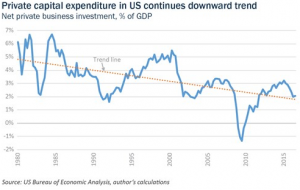Steve H. Hanke: Public Infrastructure Full of Hot Air
2017-03-30 IMI Investment fuels productivity. So, with little fuel, one should expect weak US productivity numbers. Productivity growth is indeed weak and has been trending downward. The US is in the grips of the longest slide in productivity growth since the late 1970s. Advocates of the secular stagnation theory assert that the deficiency in net private investment and the resulting productivity slump can be made up by public works spending.
Escaping fiscal austerity
This argument has been put forward many times in the past, but seems to be gaining ground as a means of escaping fiscal austerity. If proposed public works proceed as projected, the government financing magnitudes would be stunning. The McKinsey Global Institute estimated that annual spending of $3.7tn per year between 2013-30 was ‘required’ worldwide.
Trump has jumped on this infrastructure bandwagon by proposing a $1tn public works programme. But the alleged benefits of infrastructure spending are often wildly inflated, with cost estimates downplayed or distorted.
Analysis of the economic multiplier of infrastructure spending – around 1.6 by some estimates – is often flawed due to incorrect assumptions, and can be subject to misuse in the artificial inflation of benefits.
Once public works are installed, the hot air comes out of their alleged benefits. These projects are poorly maintained, and users are often not charged for what they use, or they are charged prices set well below the relevant costs incurred. Water is a classic case – on average 34% of the water delivered to water systems is either stolen or leaks out of distribution systems. It is hard to take seriously claims that billions of dollars are required to develop more water resource capacity when much of the water produced in existing systems leaks away. Adjusting for leaks and thefts, the alleged benefits for many new projects, which have been inflated by ‘multipliers’, wither away to almost nothing.
The reality of infrastructure funding
Infrastructure projects are always subject to cost overruns. While the projects might look good on paper, the reality is very different. Detailed studies show that the average ratios of actual costs to estimated costs for public works projects in the US typically range from 1.25 to over 2.
In addition to cost overruns, the financing of infrastructure requires the imposition of taxes, and taxes impose costs beyond the amount of revenue raised. The excess burdens of taxation include ‘deadweight’ distortions, enforcement and compliance costs. In short, it costs more than a dollar to finance a dollar in government spending. The best estimates indicate that, on average, it costs between $1.50 to $1.60 to raise a dollar in tax revenue.
Taking proper account of cost overruns and the costs of collecting taxes, one wonders if there are any public works projects that could justify federal financing, let alone financing to the tune of $1tn. This is the wonderful world of infrastructure waste, fraud, and abuse.
Investment fuels productivity. So, with little fuel, one should expect weak US productivity numbers. Productivity growth is indeed weak and has been trending downward. The US is in the grips of the longest slide in productivity growth since the late 1970s. Advocates of the secular stagnation theory assert that the deficiency in net private investment and the resulting productivity slump can be made up by public works spending.
Escaping fiscal austerity
This argument has been put forward many times in the past, but seems to be gaining ground as a means of escaping fiscal austerity. If proposed public works proceed as projected, the government financing magnitudes would be stunning. The McKinsey Global Institute estimated that annual spending of $3.7tn per year between 2013-30 was ‘required’ worldwide.
Trump has jumped on this infrastructure bandwagon by proposing a $1tn public works programme. But the alleged benefits of infrastructure spending are often wildly inflated, with cost estimates downplayed or distorted.
Analysis of the economic multiplier of infrastructure spending – around 1.6 by some estimates – is often flawed due to incorrect assumptions, and can be subject to misuse in the artificial inflation of benefits.
Once public works are installed, the hot air comes out of their alleged benefits. These projects are poorly maintained, and users are often not charged for what they use, or they are charged prices set well below the relevant costs incurred. Water is a classic case – on average 34% of the water delivered to water systems is either stolen or leaks out of distribution systems. It is hard to take seriously claims that billions of dollars are required to develop more water resource capacity when much of the water produced in existing systems leaks away. Adjusting for leaks and thefts, the alleged benefits for many new projects, which have been inflated by ‘multipliers’, wither away to almost nothing.
The reality of infrastructure funding
Infrastructure projects are always subject to cost overruns. While the projects might look good on paper, the reality is very different. Detailed studies show that the average ratios of actual costs to estimated costs for public works projects in the US typically range from 1.25 to over 2.
In addition to cost overruns, the financing of infrastructure requires the imposition of taxes, and taxes impose costs beyond the amount of revenue raised. The excess burdens of taxation include ‘deadweight’ distortions, enforcement and compliance costs. In short, it costs more than a dollar to finance a dollar in government spending. The best estimates indicate that, on average, it costs between $1.50 to $1.60 to raise a dollar in tax revenue.
Taking proper account of cost overruns and the costs of collecting taxes, one wonders if there are any public works projects that could justify federal financing, let alone financing to the tune of $1tn. This is the wonderful world of infrastructure waste, fraud, and abuse.
